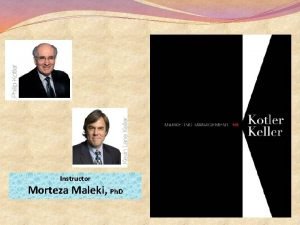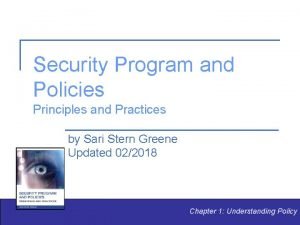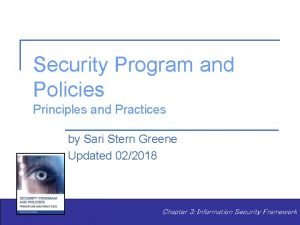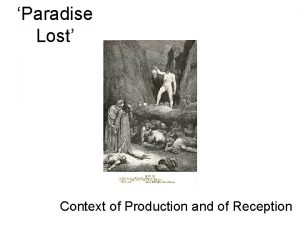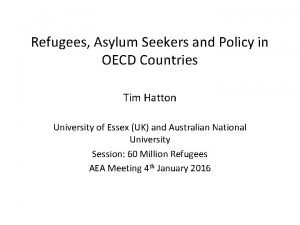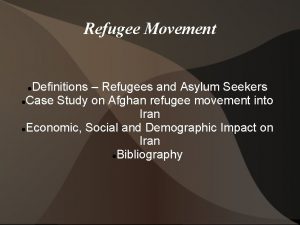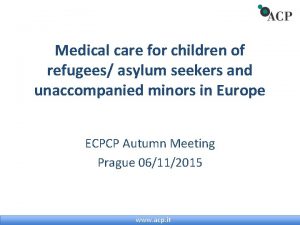Reception policies for asylum seekers and refugees in

































- Slides: 33

Reception policies for asylum seekers and refugees in Belgium: dynamics in decision making In the framework of BELSPO PUMOMIG Prof. dr. Annie Hondeghem Elien Diels Sarah De Coster

2 Public Governance Institute

Introductory facts 2015 - Europe: more than 1. 000 asylum demands - Belgium: 45. 000 asylum demands Reception system under pressure Asylum crisis >< reception crisis 3 Public Governance Institute

Research Questions How is reception policy towards asylum seekers developed in Belgium? What is the policy problem? 4 Who are the main policy actors and how are they related to one another? Has there been a change in vision as a result of the reception crisis? How are decisions made, both on the number and location of reception places and on the responsible institution? Public Governance Institute

Methodology - Document analysis - Reception law 2007 - Coalition agreement - Policy papers - Report of the Court of Audit 2017 - Annual reports Fedasil, Vluchtelingenwerk Vlaanderen - Interviews - Policy making actors - Policy implementation actors - Nongovernmental actors, civil society actors 5 Public Governance Institute

What is the policy problem? 6 Public Governance Institute

What is the policy problem? 2015 7 2019 Public Governance Institute


Facts and figures Evolution of the number of persons that asked for international protection between 2009 and 2018 and evolution of the recognition rate Total Recognition rate 17. 206 21. 675 25. 583 18. 452 12. 061 14. 131 39. 064 14. 670 15. 373 19. 038 5. 748 4. 884 6. 688 9. 899 9. 161 8. 717 5. 696 4. 040 4. 315 4. 405 22. 954 26. 559 32. 271 28. 351 21. 222 22. 848 44. 760 18. 710 19. 688 23. 443 22, 5% 28, 1% 37, 7% 52, 7% 57, 7% 50, 7% 49, 1% Decreased over time Next demands Increased over time 2009 2010 2011 2012 2013 2014 2015 2016 2017 2018 1 st demands Source: www. CGVS. be 9 Public Governance Institute

Facts and figures Source: CGVS 10 Public Governance Institute

Volatility of reception of asylum seekers 11 Public Governance Institute

Who are the main policy actors and how are they related to one another? 12 Public Governance Institute

Actors & relationships between actors Institutional context Federal state; competences divided between levels of government 13 Competence Level of government Actor Legislation, procedure and collective reception Federal government State Secretary Fedasil Initiatives for integration Regional government Flemish minister for integration Agency for integration Local government Local authorities Nongovernmental organizations Public Governance Institute

Actors & relationships between actors 14 Public Governance Institute

A story of many principals and many agents Principal-agent theory: Economical approach – Rational choice “Principals hire agents because the latter are experts that have specific knowledge (assets) required for the job and are therefore much better able to perform the work and do so at a more cost-efficient price. ” (Van Thiel, 2016). 15 Public Governance Institute

A story of many principals and many agents Principal-agent theory: assumptions: - Information asymmetry Adverse selection Moral hazard - Goal divergence Solution: Steering 16 Public Governance Institute

Actors & relationships between actors 17 Public Governance Institute

Steering instruments Coalition agreement, budget Policy note, budget, management plan Legislation, budget Conventions, contracts, instructions 18 Contracts, instructions Public Governance Institute

Actors & relationships between actors Polit ical salie nce 19 Public Governance Institute

Has there been a change in vision as a result of the reception crisis? 20 Public Governance Institute

Changes in vision • Financial support material support • Priority to collective reception Shortening of the procedure BUT ALSO fear of attraction effects • Traditional reception model new reception model First collective 6 months request transfer Transfers reserved for high recognition rate and vulnerable groups 21 Public Governance Institute

How are decisions made, both on the number and location of reception places and on the responsible institution? 22 Public Governance Institute

Decision making regarding opening en closing of reception places: Opening of centers • Crisis 2015: new reception places had to be created: Fedasil! • Location of the centers Political decision: number of mayors of different parties, sensitivities Pragmatic decision: availability of buildings Empty barracks, real estate offices, holiday centers, youth movement centers etc. • Influence of local government on decision making almost zero 23 Public Governance Institute

Decision making regarding opening en closing of reception places: Closing of centers • Decreased influx: reduction of the number of reception places 2016 phase 1: Criteria: Reception places of bad quality, too expensive places, finishing contracts, reception places exploited by private sector actors + Political criteria 2018 phase 2: Criteria: Political criteria: Reception centers which had been opened most recently 24 Public Governance Institute

Decision making regarding opening en closing of reception places: Opening and closing of Local Reception Initiatives • Local governments have a lot of autonomy towards the federal government • Plan to spread Local Reception Initiatives BUT voluntary offer was sufficient plan not implemented yet Decision making is less political 25 Public Governance Institute

Conclusions • More restrictive policy Shift in vision: priority to collective reception rather than individual reception • Reception policy is clear example of multi-level and multi-actor governance Chain in principal-agent relations Dependencies Steering instruments 26 Public Governance Institute

Conclusions • Importance of political salience in decision making • Limited role of local governments in decision making on collective reception centers How to increase this role in order to enhance support from local population? 27 Public Governance Institute

How to prevent tragic events? ? ? 28 Public Governance Institute

Some statements to discuss Statement 1: “The focus should shift from collective reception centers to individual reception. ” https: //pollev. com/eliendiels 024 29 Public Governance Institute

Some statements to discuss Statement 2: “The new reception model has contributed to a better management of the reception of asylum seekers. ” https: //pollev. com/eliendiels 024 30 Public Governance Institute

Some statements to discuss Statement 3: “Providing buffer capacity would lead to more continuity and less inefficiency in resources. ” https: //pollev. com/eliendiels 024 31 Public Governance Institute

Some statements to discuss Statement 4: “Local governments should have more decision making power when it comes to reception of asylum seekers. ” https: //pollev. com/eliendiels 024 32 Public Governance Institute

Contact Prof. Dr. Annie Hondeghem Annie. hondeghem@kuleuven. be Elien Diels Elien. diels 1@kuleuven. be Sarah Decoster Sarah. decoster@hotmail. com Public Governance Institute
 Paul mange johansen
Paul mange johansen The asylum
The asylum Asylum link merseyside
Asylum link merseyside Sources of international law
Sources of international law Bethpage asylum office
Bethpage asylum office Refugees brian bilston lesson
Refugees brian bilston lesson Immigration policies definition ap human geography
Immigration policies definition ap human geography Capoeira 4 refugees
Capoeira 4 refugees Refugees
Refugees Capoeira 4 refugees
Capoeira 4 refugees Types of seekers
Types of seekers Designing and managing integrated marketing channels
Designing and managing integrated marketing channels Seekers of yahweh ministries
Seekers of yahweh ministries Great bear lake erin hunter
Great bear lake erin hunter Treatise for the seekers of guidance
Treatise for the seekers of guidance Seeker's quorum chest
Seeker's quorum chest Job seekers
Job seekers Drug seekers scd
Drug seekers scd High value deal seekers
High value deal seekers Freedom seekers mc
Freedom seekers mc Sdlc principles and practices
Sdlc principles and practices Recruitment and induction process
Recruitment and induction process Security program and policies principles and practices
Security program and policies principles and practices Security program and policies principles and practices
Security program and policies principles and practices Security program and policies principles and practices
Security program and policies principles and practices Security program and policies principles and practices
Security program and policies principles and practices Reception theory examples
Reception theory examples Letters and sounds reception
Letters and sounds reception Context of production
Context of production Pgp message generation and reception
Pgp message generation and reception Privacy enhanced mail (pem)
Privacy enhanced mail (pem) Context of wuthering heights
Context of wuthering heights Macbeth context
Macbeth context Fspos vägledning för kontinuitetshantering
Fspos vägledning för kontinuitetshantering


















